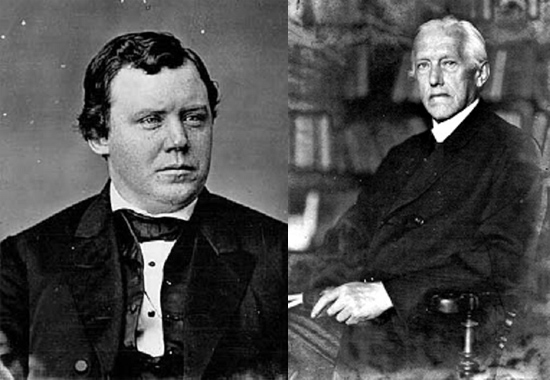
Did extraordinary natural events inspire ancient traditions? Yes, according to Ignatius Donnelly (1831-1901) (left). No, according to Ulrich Von Wilamowitz-Möllendorf (1848-1931) (right).
Mar 12, 2012
Ever since the gradualist doctrine natura non facit saltus cast an ossifying spell on the academic community, catastrophist theories of myth and other traditions have been anathema to the learned.
Some envisioned events considerably more dramatic than an earthquake or volcanic eruption. Hedwig Gollob was an Austrian art historian who sensed that some profound ‘experiential truth’ informed mankind’s collective mythological legacy:
‘There is something remarkable about legends and traditions … One gets the impression that they are all related to each other in the sense of a late reflex of some great experiential truth that once prevailed across the entire inhabited earth.’
But what sort of universal Erlebniswahrheit could that have been? An anonymous editor of the Larousse Encyclopedia of Mythology (1969) inclined to the idea of extreme celestial events explaining the unity of world mythology:
‘Does this mean that Humanity was once upon a time reduced to a little group of individuals who later spread over the earth, bringing with them their legends which they altered through the centuries in accordance with new climates and new habits? Or, as seems more probable, are all these legends a confused account of great events on a planetary scale which were beheld in terror simultaneously by the men scattered everywhere over the world?’
More recently, the American classicist Thomas Worthen emphasised that many an early theory of myth, such as James Frazer’s model, ‘covers only a minor portion of the extant material and fails to account for its most dramatic elements: these myths speak more strikingly of utter catastrophe than of reliable seasonal succession. The sun reversed its course at Atreus’s crimes; the Milky Way is the burned-out track that the sun used to follow before the ride of Phaethon. Here we see something closer to man’s loss of Eden, not the mythical equivalent of an occasional drought or of predictable seasonal change’. Oddly, however, Worthen proceeded to seek the inspiration for such myths in a phenomenon far more anodyne than seasonal changes – the precession of the equinoxes.
Others flirted with the possibility that myths embed knowledge about a time when the natural world presented a different appearance than it does now. Roland Robinson (1912-1992) was a highly esteemed Australian writer, who observed that indigenous Australian myths about the ‘Dreamtime’ are ‘In an astonishing manner … consistent with our scientific knowledge of this past era’:
‘All along the coast of New South Wales the various tribes have prevailing myths which speak of geographical changes identical with those brought about by the Ice Age. An initiated man of the Ngumbarr tribe at Port Macquarie told me that a myth of his people said that at one time all the land in the world was joined up in one big country. Then the big flood came and covered the world. As the water began to go down, the land was divided into continents and islands. Some people were left on one of these islands. The narrator told me that he thought this “island” might have been “that country called Africa”.’
Just so, a tradition relayed by Dieri informants (northern South Australia) offers ‘an accurate description of the Permian period when Australia was inhabited by many animals that are now extinct’: ‘Among them was the Diprotodon, a wombat-like creature as large as the rhinoceros; the Genyornis, a flightless bird much larger than the emu; and a kangaroo standing over three metres high. The myth also describes the gradual deterioration of these fertile areas. This happened ten thousand years ago when the climate of the world became warm again, the great icefields melted, and the oceans rose, submerging the land bridges’.
Like other scholars brave enough to air their suspicions, Robinson stopped short of explaining just how non-Western people could have handed down accurate traditional knowledge concerning the last glacial period. The French Assyriologist Françoise Brüschweiler dithered similarly, wondering whether the theme of a rope dangling from the celestial pole was merely a figment of the ancient Mesopotamian imagination or whether the sky may once really have been linked to the earth in some unfathomable way. Doors were opened, but no thresholds crossed.
Unless such restraint was dictated by fear for their reputation among peers, the likes of Robinson and Brüschweiler may well have been at a genuine loss to account for the perplexing message they retrieved from the myths at hand. Be that as it may, the taboo is slowly lifting on open discussions of past environmental changes and their relation to mythology. The ‘new mythologists’ who represent this burgeoning school of catastrophism, of very diverse plumage, may rest assured that the baton has always been passed on, continuously from the Enlightenment to the present day. As history is written by winners, however, the ‘losers’ await discovery like muted fossils trapped in a rapidly deposited sediment of intellectual inertia. Will a flood of new insights and the fire of discovery at last expose the casualties of past misfortune?
Rens Van Der Sluijs
Books by Rens Van Der Sluijs:
Traditional Cosmology: The Global Mythology of Cosmic Creation and Destruction












